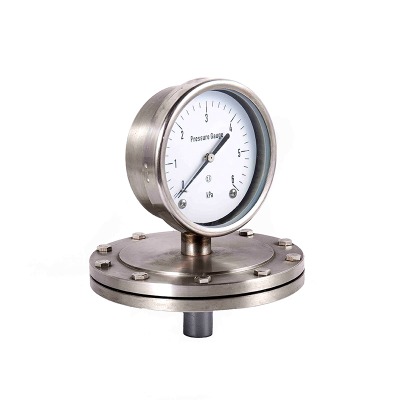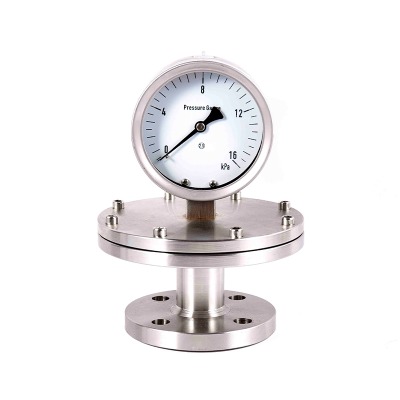YN series 100% copper connection earthquake-resistant (seismic) pressure gauge
Cat:Pressure Gauge
◆ Model: YN40 YN50 YN60 YN75 YN100 YN150◆ Use: This series of instruments have good shock resistance...
See DetailsThe diaphragm pressure gauge is an instrument that measures pressure based on the principle of deformation of an elastic diaphragm,Its core advantage lies in the ability to directly handle viscous, particulate, crystalline or corrosive media.To avoid the failure problems of ordinary pressure gauges (such as diaphragm pressure gauges) caused by medium blockage or corrosion.The following is explained from two aspects the prototype application and the usage points: 

Prototype Application
1.Chemical Industry
Measure the pressure of corrosive media (such as acid and alkali solutions, chlorine gas, sulfides) or viscous materials (such as resins, paints).For example: Monitoring of pressure inside the reaction vessel, control of pressure in acid and alkali pipelines, the material of the diaphragm (such as Hastelloy or polytetrafluoroethylene) can resist corrosion by the medium, preventing leakage or damage to the instrument.
2.Food and pharmaceutical industry
Used for sanitary applications, such as in dairy products,Wine industry, sauces, pharmaceutical liquids, etc., for measuring the pressure of viscous or easily contaminated media. The diaphragm is made of stainless steel (316L) or food-grade polytetrafluoroethylene, with a smooth surface without dead corners. It can withstand cleaning and disinfection (such as steam sterilization), avoiding residual contamination of the medium.
3.Environmental Protection and Wastewater Treatment
Measure the pressure of particle-containing media such as sewage, sludge, and mud, such as the pressure at the outlet of the sedimentation tank and the pressure in the sludge transportation pipeline.The rigid structure of the diaphragm can resist particle erosion and is not prone to clogging (without long narrow channels), thus solving the "blocked gauge" problem of ordinary pressure gauges.
4.Light Industry and Printing & Dyeing Industry
It is used for pressure monitoring in media such as sizing agents (for printing and dyeing) and high-temperature soap solutions. The diaphragm can withstand moderate to low temperatures (typically -40 to 150℃, and with special materials, even higher temperatures), and is resistant to the adhesion of viscous media, ensuring long-term stable measurement.
Operation Key
1.Selection Core
· Medium characteristics: Select the material of the diaphragm based on the corrosiveness of the medium (e.g., polytetrafluoroethylene diaphragm for measuring strong acids, 304 stainless steel for weakly corrosive media, and Hastelloy alloy for highly corrosive media); when there are hard particles, a thicker and wear-resistant diaphragm should be selected (e.g., stainless steel with a thickness of 1.5mm or more).
·Pressure range: The measurement range of the diaphragm pressure gauge is usually 0 to 6 MPa (dominated by low pressure, while high pressure requires the use of corrugated diaphragms to enhance rigidity, and the measured pressure should fall within the range of 1/3 to 2/3 of the measurement range (to avoid permanent deformation of the diaphragm due to overpressure).
·Temperature adaptation: If the medium temperature is too high (more than 150℃), it will affect the elasticity of the diaphragm. Therefore, it is necessary to select a material that can withstand high temperatures (such as Monel alloy) or install a condensation ring (to reduce the contact temperature of the diaphragm).
2.About Installation
·Installation position: Prefer vertical installation (with the diaphragm facing downwards) to prevent the medium from depositing on the diaphragm surface; if installed horizontally, ensure that the diaphragm is parallel to the pipeline axis to reduce particle impact.
·Connection method: Use flange or threaded connection (depending on the pipe specification), ensuring a tight seal (the gasket material should be compatible with the medium, such as a polytetrafluoroethylene gasket for acid resistance), to prevent the leakage of the medium from corroding the instrument housing.
· Avoid interference: Stay away from strong vibration sources (such as pump bodies) or strong magnetic fields. If necessary, install shock-absorbing brackets to prevent the diaphragm from becoming fatigued or the pointer from shaking, which could affect the reading.
3.Operation and Maintenance
·Pre-start inspection: Ensure that the range matches the measured pressure (prohibition of overpressure use), and the membrane surface is free from damage, deformation, and the pointer is at zero (when no pressure is present).
·Daily reading: After the pointer stabilizes, read the value (during the flow of the medium, there may be fluctuations, and a damping device can be used to smooth the pointer); if measuring a viscous medium, it is necessary to manually clean the surface of the diaphragm periodically (for example, through the blow-off valve).
·Regular maintenance:
Conduct monthly checks on the diaphragm's sealing performance (no leakage, no bulging).
Calibration is conducted once every six months (by comparing with a standard pressure source. If the deviation exceeds 1.6 levels, the transmission mechanism needs to be adjusted).
If the medium contains corrosive components, the diaphragm should be replaced annually (to prevent degradation and subsequent decline in accuracy).
Summary:
The prototype design of the diaphragm pressure gauge is centered around ""pressure measurement in harsh media"", and is mainly applied in industries such as chemical engineering, food processing, and environmental protection. When using it, special attention should be paid to material compatibility, installation protection, and regular maintenance to ensure its long-term stable operation.